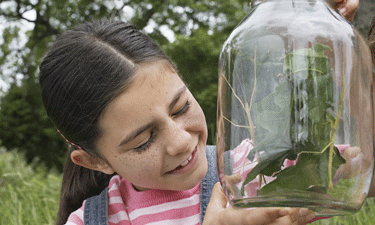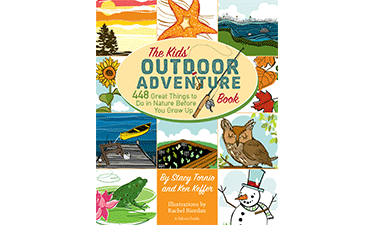 I’d like to introduce you to a little something I call Nature Immersion Therapy. It’s not something fancy, extravagant or complicated. In its simplest form, Nature Immersion Therapy is about getting kids back outside. And it directly supports the 10 Million Kids Outdoors initiative, aiming to get children outside — one classroom, one family and one kid at a time.
I’d like to introduce you to a little something I call Nature Immersion Therapy. It’s not something fancy, extravagant or complicated. In its simplest form, Nature Immersion Therapy is about getting kids back outside. And it directly supports the 10 Million Kids Outdoors initiative, aiming to get children outside — one classroom, one family and one kid at a time.
On the second anniversary of this initiative, I can’t help but think about my experiences of yesteryear. At the risk of overly romanticizing the past, I remember when growing up was about gathering the neighborhood for a game of Kick the Can or Capture the Flag. Instead of electronic play, we were building forts in the backyard, flying a kite in an open field and exploring the woods at a nearby park or nature center. Winter was a time for snowball fights and skiing in the park. This certainly sums up much of my youth. I’m convinced there is a stretch of bike path in Wyoming that is still rutted from the countless miles I put on it as a kid.
It’s easy to think that those days are in the past, but as a naturalist, environmental educator and writer, I’m here to tell you that childhood is still about the essentials of outdoor play and learning. When you immerse a kid in nature, cool and amazing things happen.
Much has been written about how childhood has changed in recent years, and the news is often alarming. From increased rates of childhood obesity and mental health disorders, to the lack of access to green space in an ever-paved-over planet, we hear that childhood is doomed. In the 10 years since the publication of Richard Louv’s Last Child In the Woods, Nature Deficit Disorder has become a growing concern.
Luckily, there is a cure. A growing body of research has demonstrated that both structured and unstructured outdoor play and learning have numerous benefits to children. So whether your Nature Immersion Therapy with kids includes summer camps, field trips or just exploring at the local park, you can make a difference.
Green space is a stress reliever, and it can have amazing effects on kids. Teachers often note that some of their most rowdy students show an unprecedented focus when on outdoor field trips. Kids who can barely sit still for math tests will sit and count the legs of a dozen millipedes. Outdoor time can also reduce Attention Deficit Hyperactivity Disorder symptoms including inattention and impulsivity. And as a bonus, it also increases critical thinking skills in children.
Outdoor learning facilitates health and wellness. Students can imagine a raindrop falling from the sky, but when they become raindrops rolling down the hill, they really connect with the watershed. Bonus — they’re exercising without even realizing it!
There is remarkable nature everywhere, not just in far-flung destinations. I’ve worked with students from one-roomed schools in Wyoming to the urban youth of downtown Milwaukee, and with a bit of enthusiastic encouragement, backyard biodiversity becomes as intriguing as the plains of Africa or the Australian outback. This fall, I overheard a student whispering to himself in near disbelief, “That huge tree started out like that little sapling!” He knew this to be true, but the sincerity of that simple connection reinforced the value of outdoor experiences to me.
While technology takes much of the heat for the shift in childhood and Nature Deficit Disorder, it can’t take all the blame. Yes, it might take a little more encouragement to get kids outdoors these days, but outdoor adventure still awaits. Childhood is still a glorious time, and children are still really good at being kids. Curiosity, wonder and the playful spirit of youth prevail.
So now it’s up to us to keep encouraging those 10 million kids to get outside. The outdoors is a necessary and valuable part of childhood, and it should be experienced to the fullest. Sharing the outdoors is inspiring and essential work. Let the Nature Immersion Therapy begin.
Ken Keffer is a Naturalist with Milwaukee County Parks in Wisconsin.
The Kids’ Outdoor Adventure Book: 448 Great Things to Do in Nature Before You Grow Up, By Stacy Tornio and Ken Keffer
 “Go outside and play!” It’s a directive we heard from our parents as children, and it’s likely one we’ve handed down to our own kids. But, in today’s world of video games and structured activities, children may be at a loss when it comes to figuring out what to do once they’ve been ushered off the couch and into the backyard or local park. Fortunately, Stacy Tornio and Ken Keffer took the time to gather hundreds of suggestions and solutions to make outdoor play fun, exciting, educational and interactive.
“Go outside and play!” It’s a directive we heard from our parents as children, and it’s likely one we’ve handed down to our own kids. But, in today’s world of video games and structured activities, children may be at a loss when it comes to figuring out what to do once they’ve been ushered off the couch and into the backyard or local park. Fortunately, Stacy Tornio and Ken Keffer took the time to gather hundreds of suggestions and solutions to make outdoor play fun, exciting, educational and interactive.
The Kids’ Outdoor Adventure Book divides these activities into seasons, so there’s always something to do no matter the weather. Torino and Keffer suggest games, projects and even simple recipes to make healthy foods with kids, as well as fun destinations for when a road trip is in order. They’ve also provided a helpful how-to section to open the book, with instructions on how to select an activity and get kids excited for all the great outdoors has to offer. This is an excellent resource for park and recreation programmers, as it includes activities that are easily translatable to a community center setting, special event or ongoing classes.
With adorable illustrations courtesy of Rachel Riordan, The Kids’ Outdoor Adventure Book is essential reading for families and park and recreation professionals, not to mention a great way to start planning activities for the New Year. Look for it at area booksellers or online.
Samantha Bartram is the Associate Editor of Parks & Recreation magazine.

